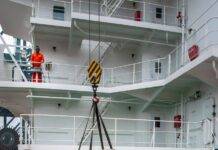
Web Sling Size and Capacity with Chart
Web Sling Size and Capacity : Web slings are an essential tool in various industries, used for lifting and securing heavy loads. They are versatile, durable, and, when chosen correctly, can make lifting operations safer and more efficient. In this article, we will delve into the world of web slings, focusing on web sling size and capacity. Understanding these factors is crucial for ensuring the safety and effectiveness of your lifting operations.
Introduction to Web Slings
Web slings, often referred to as nylon slings or polyester slings, are made from high-strength synthetic materials and are designed to be flexible, lightweight, and easy to handle. They come in various forms, such as flat web slings, round slings, and endless slings. These slings are widely used in construction, manufacturing, shipping, and various other industries for lifting and securing heavy loads.
Understanding Web Sling Size
Types of Web Slings
Web slings are available in different types, and each type has its unique characteristics and applications. The most common types include flat web slings, round slings, and endless slings. The choice of web sling type depends on the specific requirements of the lifting operation.
Web Sling Capacity
Web sling capacity refers to the maximum weight a web sling can safely lift. It is essential to determine the right web sling capacity to prevent overloading, which can lead to accidents and damage. The capacity of a web sling is affected by various factors.
Factors Affecting Web Sling Capacity
Material of the Web Sling
The material of the web sling plays a significant role in determining its capacity. Web slings are typically made from either nylon or polyester. Nylon web slings have excellent strength and resistance to abrasion, making them suitable for various applications. Polyester web slings are known for their resistance to acid, but they have a slightly lower strength compared to nylon.
Configuration and Design
The configuration and design of the web sling also influence its capacity. Different configurations, such as single-ply or double-ply web slings, affect the capacity. The design, including the width and thickness of the web sling, plays a crucial role in determining its lifting capacity.
Calculating Web Sling Capacity
Calculating the web sling capacity is essential for safety. The capacity varies depending on the type of hitch used, and there are three common types: straight vertical lift, choker hitch, and basket hitch.
Straight Vertical Lift
For a straight vertical lift, the web sling’s capacity is equal to its vertical rating. This means that the entire weight of the load is borne by the web sling, making it the most straightforward configuration.
Choker Hitch
In a choker hitch, the capacity of the web sling is reduced because the load is at an angle. It’s essential to consider the angle and calculate the capacity accordingly.
Basket Hitch
The basket hitch is another common configuration where the capacity is higher than in a choker hitch but less than in a straight vertical lift. The angle of the load is taken into account when calculating the capacity.
Here's a simple chart outlining web sling sizes and their corresponding capacities. Please note that these are general guidelines, and you should always refer to the manufacturer's recommendations for specific web slings.| Web Sling Size (Width) | Web Sling Capacity (Vertical) | Web Sling Capacity (Choker Hitch) | Web Sling Capacity (Basket Hitch) |
|---|---|---|---|
| 1 inch (25 mm) | 1,000 lbs (450 kg) | 800 lbs (360 kg) | 2,000 lbs (900 kg) |
| 2 inches (50 mm) | 2,000 lbs (900 kg) | 1,600 lbs (720 kg) | 4,000 lbs (1,800 kg) |
| 3 inches (75 mm) | 3,000 lbs (1,350 kg) | 2,400 lbs (1,080 kg) | 6,000 lbs (2,700 kg) |
| 4 inches (100 mm) | 4,000 lbs (1,800 kg) | 3,200 lbs (1,440 kg) | 8,000 lbs (3,600 kg) |
| 5 inches (125 mm) | 5,000 lbs (2,250 kg) | 4,000 lbs (1,800 kg) | 10,000 lbs (4,500 kg) |
| 6 inches (150 mm) | 6,000 lbs (2,700 kg) | 4,800 lbs (2,160 kg) | 12,000 lbs (5,400 kg) |
| 8 inches (200 mm) | 8,000 lbs (3,600 kg) | 6,400 lbs (2,880 kg) | 16,000 lbs (7,200 kg) |
| 10 inches (250 mm) | 10,000 lbs (4,500 kg) | 8,000 lbs (3,600 kg) | 20,000 lbs (9,000 kg) |
This chart provides a general idea of web sling capacities based on their width for both vertical, choker hitch, and basket hitch configurations. Remember to consider the specific type and material of the web sling, as well as other factors that may affect the capacity in real-world lifting operations. Always follow manufacturer guidelines and relevant safety standards.
Choosing the Right Web Sling Size
Selecting the right web sling size is crucial for ensuring safety and efficiency. It depends on factors like the type of load, weight, shape, and hitch configuration. It’s essential to consult the manufacturer’s guidelines and calculate the capacity accurately to make an informed choice.
Safety Considerations
Safety should always be a top priority when using web slings. Inspecting the slings for wear and tear, avoiding sharp edges, and maintaining proper load control are essential for safe lifting operations. Regular training of personnel is also crucial to ensure safe usage.
Proper Maintenance of Web Slings
To prolong the life of your web slings and maintain their reliability, proper maintenance is necessary. Regular inspections, cleaning, and storage in a cool and dry place are essential steps to ensure the longevity of your slings.
Advantages of Web Slings
Web slings offer numerous advantages, such as flexibility, lightweight design, and ease of use. They are also less likely to damage delicate surfaces, making them ideal for various applications.
Disadvantages of Web Slings
While web slings are versatile, they do have some disadvantages. They are sensitive to sharp edges and chemicals and may not be suitable for extremely high-temperature environments.
Common Applications of Web Slings
Web slings find applications in various industries, including construction, manufacturing, shipping, and more. They are used for lifting loads such as machinery, equipment, and construction materials.
Comparing Web Slings to Other Lifting Equipment
It’s essential to understand how web slings compare to other lifting equipment, such as wire ropes and chains. Each type has its advantages and disadvantages, and the choice depends on the specific requirements of the lifting operation.
Conclusion
In conclusion, web sling size and capacity are critical factors in ensuring safe and efficient lifting operations. Choosing the right web sling, calculating its capacity, and adhering to safety guidelines are essential for a successful lifting operation. Web slings are versatile tools with various advantages, making them a valuable asset in various industries.
Types of Crane in Construction
Crane Lifting Safety Toolbox Talk Meeting
Lost Time Incident Rate and How To Calculate LTI
FAQs
- What are the main types of web slings?There are three main types of web slings: flat web slings, round slings, and endless slings.
- How do I calculate the capacity of a web sling for a choker hitch?The capacity for a choker hitch is determined by considering the angle of the load. You should refer to manufacturer guidelines or use relevant tables and formulas for accurate calculations.
- Can web slings be used in extreme temperature conditions?Web slings are sensitive to extreme temperatures and chemicals, so it’s essential to consider the environment and choose the right type of sling for the conditions.
- What are the advantages of using web slings over other lifting equipment?Web slings are flexible, lightweight, and less likely to damage delicate surfaces. They are also suitable for various applications.
- How often should web slings be inspected and maintained?Web slings should be inspected and maintained regularly, following manufacturer guidelines. This helps ensure their longevity and safety in lifting operations.
























